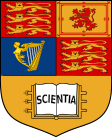Partnership for Child Development
School Health & Nutrition, Poverty reduction | |
| Location | |
|---|---|
| Origins | University of Oxford |
Area served | Global |
| Method | Capacity building, knowledge dissemination, building the evidence base and building global partnerships. |
| Website | http://www.imperial.ac.uk/partnership-for-child-development |
The Partnership for Child Development (PCD) is a
History
Based on a growing evidence base for the beneficial nature of
Organisational focus
PCD supports low-income countries to meet their school health needs using the findings of evidence-based research. PCD is a knowledge-based institution which creates and shares information. Core health interventions that PCD supports are school feeding & nutrition, deworming, water and sanitation, disability screening, and health education.[4]
It conducts operational research showing how interventions can be implemented and evaluated at the country level, for example enabling mass treatment of children for common infections such as
A major function of PCD is capacity building, by means of courses and workshops for governmental and non-governmental staff in developing countries. These include annual training courses in school-based health, nutrition in sub-Saharan Africa and Asia in partnership with local academic organisations such as Mahidol University, the University of Ghana, and the Kenya Medical Research Institute.[8][9]
PCD are a core member of
References
- ^ Nokes C (1996), Journal of Biosocial Science [1] A healthy body and a healthy mind? : The relationship between ill-health and cognitive function in school-age children. Accessed 28 March 2012.
- ^ "A. Cerami & K.S. Warren, Drugs, Parasitology Today, Vol. 10" (PDF). Elsevier. Retrieved 17 September 2014.
- ^ Bundy, Donald. Rethinking School Health: A Key Component of Education for All (1st ed.). World Bank. p. 84.
- ^ "New NTD Data to Inform Large Scale Deworming in Ethiopia". The Communication Initiative. Retrieved 18 September 2014.
- ^ Jamison, D. T., J. G. Breman, A. R. Measham, G. Alleyne, M. Claeson, D. B. Evans, P. Jha, A. Mills, and P. Musgrove. Disease Control Priorities II. Oxford University Press. p. Chapter 58. Archived from the original on 23 January 2013. Retrieved 17 September 2014.
{{cite book}}: CS1 maint: multiple names: authors list (link) - ^ "Measuring the education sector response to HIV and AIDS" (PDF). UNESCO. UNESCO, Paris. Retrieved 17 September 2014.
- PMID 24019380.
- ^ "Report of the 2nd Training Course on School Health and Nutrition Programmes in Asia" (PDF). Mahidol University, Faculty of Tropical Medicine. Retrieved 18 September 2014.
- ^ "UNAIDS Inter-Agency Task Team (IATT) on Education Member Activities" (PDF). UNESCO. Retrieved 18 September 2014.
- ^ "The FRESH M&E Framework A Generic Framework for Monitoring and Evaluation of School Health Interventions" (PDF). World Bank. World Bank, Washington D.C. Retrieved 18 September 2014.
Further reading
- Jamison, D. T., J. G. Breman, A. R. Measham, G. Alleyne, M. Claeson, D. B. Evans, P. Jha, A. Mills, and P. Musgrove, ed. 2006. Disease Control Priorities in Developing Countries, 2nd ed. New York: Oxford University Press. [2]

